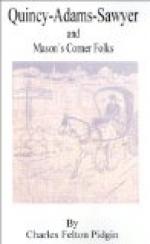On the upper road, about half a mile to the west of Deacon Mason’s, lived Mr. and Mrs. Silas Putnam. They owned the largest house and best farm at Mason’s Corner. They were reputed to be quite wealthy and it was known for a sure fact that their only daughter, Lindy, was worth one hundred thousand dollars in her own right, it having been left to her by her only brother, J. Jones Putnam, who had died in Boston about five years before.
Mrs. Hawkins had a large house, but it was always full of boarders, all of the masculine gender. Mrs. Hawkins had declared on several occasions that she’d “sooner have the itch than a girl boarder.” She was a hard-working woman and had but one assistant, a young girl named Betsy Green, one of whose sisters was “working-out” up at Mrs. Putnam’s. Mrs. Hawkins’s husband, his wife declared, was “no account nohow,” and for the present her estimate of him must be accepted without question.
Among Mrs. Hawkins’s twelve boarders were Robert Wood and Benjamin Bates, two young men who were natives of Montrose. Bates was a brick and stone mason, and Wood was a carpenter, and they had been quite busily employed during the two years they had lived at Mason’s Corner.
Mrs. Hawkins owned a buggy and carryall and a couple of fairly good horses. They were cared for by Abner Stiles. He was often called upon to carry passengers over to the railway station at the Centre, and was the mail carrier between the Centre and Mason’s Corner, for the latter village had a post office, which was located in Hill’s grocery, Mr. Benoni Hill being the postmaster.
Since his return from the war Mr. Obadiah Strout had been Mrs. Hawkins’s star boarder. He sat at the head of the table and acted as moderator during the wordy discussions which accompanied every meal. Abner Stiles believed implicitly in the manifest superiority of Obadiah Strout over the other residents of Mason’s Corner. He was his firm ally and henchman, serving him as a dog does his master, not for pay, but because he loves the service.
Mr. Strout was often called the “Professor” because he was the singing-master of the village and gave lessons in instrumental and vocal music. The love of music was another bond of union between Strout and Stiles, for the latter was a skilful, if not educated, performer on the violin.
The Professor was about forty years of age, stout in person, with smooth shaven face and florid complexion. In Eastborough town matters he was a general factotum. He had been an undertaker’s assistant and had worked for the superintendent of the Poorhouse. In due season and in turn he had been appointed to and had filled the positions of fence viewer, road inspector, hog reeve, pound keeper, and the year previous he had been chosen tax collector. Abner Stiles said that there “wasn’t a better man in town for selectman and he knew he’d get there one of these days.”




